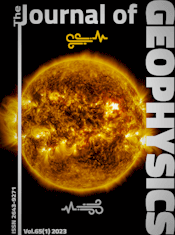Plasma-gas interactions in planetary atmospheres and their relevance for the terrestrial hydrogen budget
Article Sidebar

Vols. 1-18 (1924-1944), ISSN 0044-2801
Main Article Content
Abstract
The relevance of charge exchange processes for the evaporation of neutral gases out of planetary gravitational fields has been known for quite a long time. For the planetary escape, however, collisions of the escaping constituent with both neutral and ionized atmospheric species operate in building up the escape flux. For the Earth, hydrogen collisions with O-atoms and O+- and H+- ions lead to about comparable contributions to the hydrogen escape at heights below 800 km, whereas at larger heights only charge exchange collisions need to be considered. In the present work, the lower region is therefore described by particle and energy flux conservation concepts, whereas in the upper region free-flight kinetic concepts are used. We give solutions for the height profiles of the hydrogen density, temperature and escape flux. The inclusion of charge exchange collisions increases the scale height, and consequently a smaller decrease of the hydrogen density is given. The hydrogen temperature, however, is reduced by including this effect. The charge exchange processes contribute about 70% to the total hydrogen escape which is of the order of a few 107 atoms/cm2 s at the plasma pause.
 ARK: https://n2t.net/ark:/88439/y085188
ARK: https://n2t.net/ark:/88439/y085188
Permalink: https://geophysicsjournal.com/article/14
Article Details
References
Brown, R.A., Schneider, N.M. (1981) Sodium remote from Io. Icarus 48, 519
Bulirsch, R., Stoer, J. (1966) Numerical treatment of ordinary differential equations by extrapolation methods. Numer. Math. 8, 1
Chamberlain, J.W. (1956) Excitation in nebulae: charge transfer and the Cassiopeia radio source. Ap. J. 124, 390
Chamberlain, J.W. (1963) Planetary coronae and atmospheric evaporation. Planet. Space Sci. 11, 901
Chamberlain, J.W. (1977) Charge exchange in a planetary corona: Its effect on the distribution and escape of hydrogen. J. Geophys. Res. 82, 1
Cloutier, P.A., Daniell, JR., R.E., Dessler, A.J., Hill, T.W. (1978) A cometary ionosphere model for Io. Astrophys. Space Sci. 55, 93
Durrance, S.T., Thomas, G.F. (1979) The 63 1-1m radiation field in the earth's thermosphere and its influence on the atomic hydrogen temperature. Planet. Space Sci. 27, 795
Eviatar, A., Siscoe, G.L., Mekler, Y. (1979) Temperature anisotropy of the jovian sulfur nebula. Icarus 39, 450
Fahr, H.J., Nass, H.U. (1978) Concerning the structure of the transition layer between the terrestrial thermosphere and exosphere. Ann. Geophys. 34, 219
Fahr, H.J., Shizgal, B. (1983) Modern exospheric theories and their observational relevance. Rev. Geophys. Space Sci. 21, 75
Fahr, H.J., Weidner, B. (1977) Gas evaporation from collision determined planetary exospheres. Mon. Not. R. Astr. Soc. 180, 593
Gross, P.G. (1974) A lower limit to Jeans' escape rate. Mon. Not. R. Astron. Soc. 167, 215
Goertz, C.K. (1980) Io's interaction with the plasma torus. J. Geophys. Res. 85, 2949
Goertz, C.K., Ip, W.-H. (1982) On the structure of the Io torus. Planet. Space Sci. 30, 855
Hodges, R.R., Rhorbough, R.P., Tinsley, B.A. (1981) The effect of the charge exchange source on the velocity and temperature distributions and their anisotropies in Earth's exosphere. J. Geophys. Res. 86, 6917
Hunten, D.M., Strobel, D.P. (1974) Production and escape of terrestrial hydrogen. J. Atmos. Sci. 31, 305
Ip, W.-H., Axford, W.l. (1980) A weak interaction model for Io and the jovian magnetosphere. Nature 283, 180
Ip, W.-H. (1982) On charge exchange and knock-on processes in the exosphere of Io. Astrophys. J. 262, 780
Jacchia, L.G. (1972) Cospar international reference atmosphere. Akademie Verlag, Berlin
Jeans, J.H. (1925) An introduction to the kinetic theory of gases. Cambridge: University Press
Lindenfeld, M.J., Shizgal, B. (1979) Non-Maxwellian effects associated with the thermal escape of a planetary atmosphere. Planet. Space Sci. 27, 739
Liu, S.C., Donahue, T.M. (1974a) The aeronomy of hydrogen in the atmosphere of earth. J. Atmos. Sci. 31, 1118
Liu, S.C., Donahue, T.M. (1974b) Mesospheric hydrogen related to exospheric escape mechanisms. J. Atmos. Sci. 31, 1466
Liu, S.C., Donahue, T.M. (1974c) Realistic model of hydrogen constituents in the lower atmosphere and escape flux from the upper atmosphere. J. Atmos. Sci. 31, 2238
Liwshitz, M., Singer, S.F. (1966) Thermal escape of neutral hydrogen and its distribution. Planet. Space Sci. 14, 541
Maher, L.J. (1980) The latitudinal variation of the charge exchange induced atomic hydrogen escape flux. J. Geophys. Res. 85, 4621
Maher, L.J., Tinsley, B.A. (1977) Atomic hydrogen escape rate due to charge exchange with hot plasmaspheric ions. J. Geophys. Res. 82, 689
Maher, L.J., Tinsley, B.A. (1978) The diurnal and solar cycle variation of the charge exchange induced hydrogen escape flux. Planet. Space Sci. 26. 855
Mapleton, R.A. (1972) Theory of charge exchange. New York: Wiley-Interscience
Raitt, W.J., Schunk, R.W., Banks, P.M. (1975) A comparison of the temperature and density structure in high and low speed thermal proton flows. Planet. Space Sci. 23, 1103
Rawer, K., Ramakrishnan, S., Bilitza, D. (1978) International reference ionosphere. International Union of Radio Science (URSI), Brlissel
Rapp, D. (1963) Accidentially resonant asymmetric charge exchange in the protonosphere. J. Geophys. Res. 68, 1773
Shizgal, B., Lindenfeld, J.M. (1982) A simple kinetic theory calculation of terrestrial atomic hydrogen escape fluxes induced by charge exchange collisions. J. Geophys. Res. 87, 853
Storm, D. A. (1970) The calculation of cross sections in various ionatom collisions. Ph. D. dissertation. Polytech. Inst. of Brooklyn
Tinsley, B.A. (1973) The diurnal variation of atomic hydrogen. Planet. Space Sci. 21, 686
Torr, M.R., Walker, J.C.G., Torr, D.G. (1974) Escape of fast oxygen from the atmosphere during geomagnetic storms. J. Geophys. Res. 79, 5267
Torr, M. R., Torr, D.G. (1979) Energetic oxygen: A direct coupling mechanism between the magnetosphere and thermosphere. Geophys. Res. Lett. 6, 700
Vidal-Madjar, A. (1978) The Earth hydrogen exobase near a solar minimum. Geophys. Res. Lett. 5, 29
Vidal-Madjar, A. (1978) Thomas, G.E.: The terrestrial hydrogen problem. Planet. Space Sci. 26, 863











